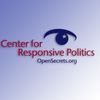Roger Marshall became only the second challenger to beat an incumbent in a Kansas House election since 1964, defeating Rep. Tim Huelskamp in the Republican primary. (Travis Morisse/The Hutchinson News via AP)
By: Soo Rin Kim
Compared to the astronomical numbers being charted in the presidential election, spending by outside groups in congressional face-offs might seem like a trickle. But House elections have also seen a jump in outside spending in the last few years, from about $29 million by this point in the 2012 election cycle to $43 million at the same point in 2014.
2016 has brought an uncharacteristic dip, though: House races have only seen $40 million spent by outside groups -- so far.
That doesn't mean the number won't shoot up. In 2014, outside groups poured about $294 million into House elections in just the last two months before Election Day.
Kansas' 1 Congressional District is on top, so far, with super PACs and politically active nonprofits laying out about $2.7 million so far. That's more than 10 times what outside groups spent there in 2014. In fact, super PACs and politically active nonprofits have outspent candidate committees by more than $1 million in the district.
"Usually, the most expensive races are the most competitive races," Campaign Legal Center Associate Counsel Brendan Fischer said, and Kansas is a case in point, featuring a fierce rivalry between incumbent GOP Rep. Tim Huelskamp and a newcomer backed by the establishment wing of the party, Roger Marshall.
Marshall, who benefited from $1.9 million spent by traditional conservative groups such as the U.S. Chamber of Commerce, defeated Huelskamp -- viewed by party leaders as a troublemaker -- in the Aug. 2 primary. Marshall became only the second challenger to beat an incumbent in a Kansas House election since 1964.
Another hot spot this cycle: Ohio's 8 Congressional District, site of a similarly intense Republican primary competition: Fifteen GOP candidates vied for the right to run in a June 7 special election called to fill the seat of former Rep. John Boehner (R). About $2.5 million in super PAC and 501(c) spending -- led by Club for Growth Action, which invested more than $1 million to bolster primary victor Warren Davidson -- was drawn to the district, more than three times the amount spent there in 2014. (Davidson prevailed in the special election as well, and is favored to win in November.)
Club for Growth has spent more in the Ohio 8th than in any other House race this election cycle so far.
But the Kansas and Ohio districts won't be seeing much more in the way of outside spending. They're both considered safe Republican seats, so the groups' attention is shifting to competitive general election races, if it hasn't already.
Take, for instance, Maine's 2nd District, rated as a major battleground this year. Neither Republican incumbent Rep. Bruce Poliquin nor Democrat Emily Cain had primary opposition after another Democratic candidate dropped out in February. Outside groups spent only $177,177 in the primaries -- but they have paid out about $1.2 million targeting the general election in the last couple months.
While Poliquin has raised $1 million more than Cain through his campaign committee, Cain has benefited from more than 80 percent of the outside spending so far, helping to equalize the competition.
Similarly, in another hot race in Nebraska, Republican nominee Don Bacon has benefited from more than half the $1 million outside groups have spent since the primaries while Democratic incumbent Rep. Brad Ashford has raised more than twice as much as he has.
Researchers Anya Gelernt-Dunkle and Douglas Weber contributed to this post.
